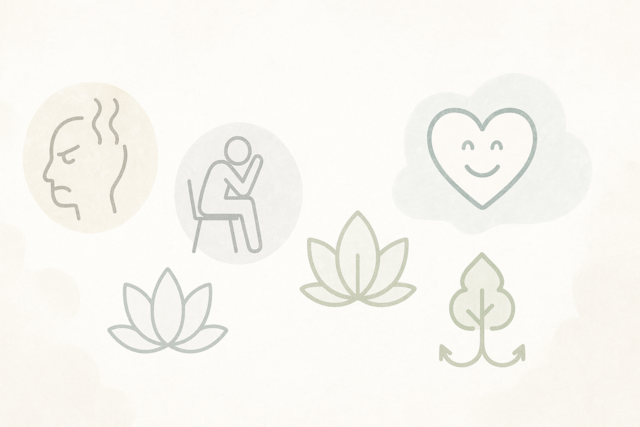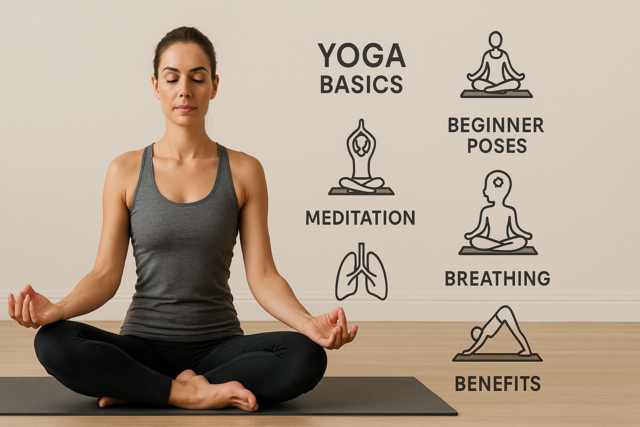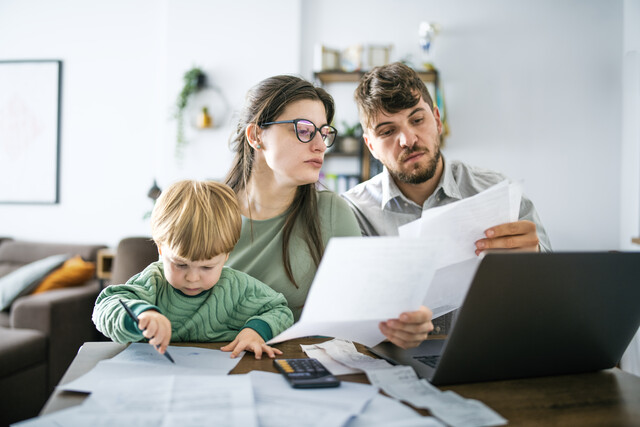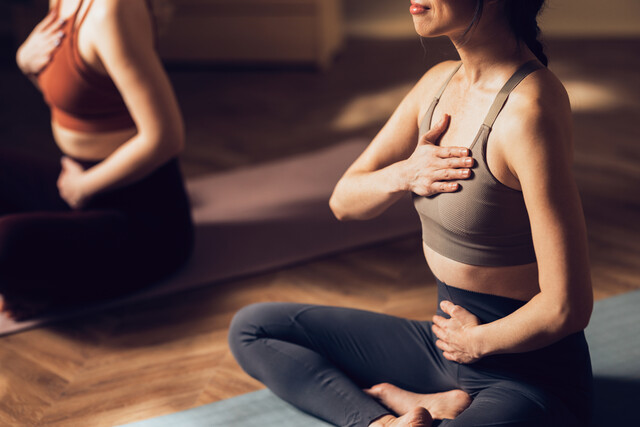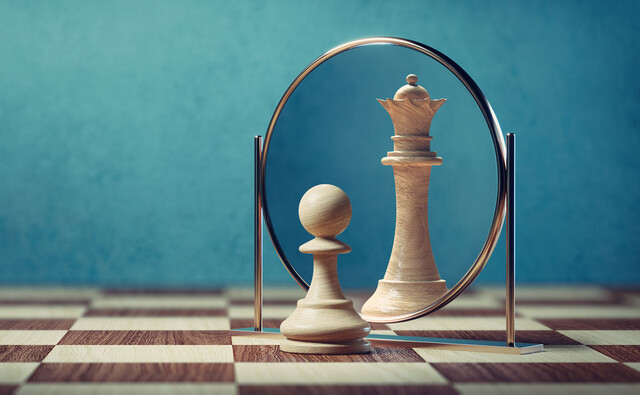Moving Meditations
-
Walking Meditation
-
Eating Meditation
For those of you who may think, "Hey, great! I like walking. I'll do my meditating while I walk," this is not what you might expect. A walking meditation is a meditation where you use the same principles as you did with the lying down or sitting meditation, only you will be moving. However, you are not walking to get anywhere. The whole point of the meditation is to simply notice how your body moves as you take first one step, and then another. You will notice your feet, and how they connect with the floor or the ground. You will notice your ankles, your shins, your knees, your thighs, your hips as you walk.
Do you remember when you learned to walk as a child? Walking is essentially falling forward but in perfect control. We take walking for granted because we've practiced it for so many years we do it without thinking about it.
That is exactly what a walking meditation is all about, thinking about walking and nothing else. You are to be totally present to your walking meditation. You can walk around your room, your house, in your back yard, in a parking lot that is empty (you want to focus on your walking meditation and not on a vehicle that might hit you.)
If you are fortunate enough to have a walking maze available, that is a perfectly fine place to practice a walking meditation, but it is absolutely unnecessary. For many walking meditators, they find that pacing ten paces one direction and then back in the opposite direction is enough for them to be able to practice their walking meditation.
You're not sight-seeing, you're not going anywhere, you're not looking at anything except enough to keep you safe. Stand upright and gaze out ahead of you. Don't focus on anything; this is called keeping your gaze soft. This is how you are to look about you while you are meditating, for when your eyes focus on something, your brain will hijack the meditating portion and try to force you to think about what it is you are seeing.
When you first begin your walking meditation, walk very slowly so that you can notice everything about your marvelous body, in how your foot lifts as it begins to take a step, how your thigh muscles contract to lift your leg and move it forward, how your foot touches the ground, begins, and then completes, a step.
While you practice your walking meditation, keep your entire focus on your walking and, if it helps, on your breathing in order to help you stay focused. Every time your attention is diverted, gently bring yourself back to your walking meditation. The only difference with a walking meditation and a stationary lying or sitting meditation is that you are moving. The focus of the meditation, however, is still to remain in the present moment for as long as you are meditating.
An eating meditation is a fun activity. The first time you do an eating meditation try to use only one or two foods. Good examples are raisins and chocolate.
For an eating meditation, the purpose is to be in the present moment with the food you are eating. First begin by noticing how your body feels. Are you hungry? If you struggle with your relationship with food, this particular meditation can be especially powerful for you because most people who battle their weight struggle with knowing if they are actually hungry, or if they are looking for comfort.
Begin your food meditation by asking yourself if you are hungry. Be still with that question for a few minutes. Allow your body time to consider whether it is hungry and if it is hungry, then prepare your body to eat.
Eating food for nutrition involves a number of steps that we often skip, because we're in such a hurry that we don't feel these steps are necessary. However, by skipping these steps, we are injuring our bodies by not allowing our bodies to digest food properly.
The first step in food digestion is noticing our hunger pangs. As we prepare to feed ourselves, we use our sense of touch as we prepare the food, our sense of smell and our sense of sight to look at the food and make ourselves ready to eat.
Neither does your body.
For your food meditation, take a single raisin. Pick it up and feel it with your eyes closed. Notice the ridges that were created as the grape dehydrated. Feel how warm or cool it is against the skin of your fingers. Now open your eyes and look at the raisin. Notice the color. It might be brown or closer to black, or it could be a yellowish green of a golden raisin. Is the skin shiny, or a dull color, perhaps with some tiny crystals of natural sugars from the dehydrated grape. After you've really looked at the raisin and noticed everything about it, close your eyes and hold it up to your nose and smell it. Notice its fragrance, slightly sweet. Pull it away from your nose and notice what you smell when the raisin is no longer right there. Smell the raisin again. Is the scent stronger this time?
Finally, place the raisin on your tongue, but do not chew it yet. Roll the raisin around inside your mouth, feeling it with your very sensitive tongue. Notice where on you tongue you notice its sweetness and where on your tongue you don't notice a taste. Finally, bite down on the raisin and notice the burst of flavor as it hits your tongue. Chew the raisin until it is completely chewed, moving it around your mouth with your tongue. Again, notice everything about the process of chewing, the process of salivating which begins the digestion process in preparation for the food to be moved into your stomach.
Now, once the raisin is completely chewed, swallow it. How far down do you notice it? Do you feel it as it moves past the back of your tongue toward your throat? Can you feel it as it passes down into your esophagus?
Continue to sit quietly, focusing on the raisin, now inside your body, now feeding and fueling your body. Have you ever noticed a lowly raisin in quite the same way before?
It is time to repeat the process with the piece of chocolate.
What was different about how you ate this piece of chocolate than any other piece of chocolate you've ever tasted before? Did you bite the chocolate, or did you allow it to melt completely in your mouth before you swallowed it?
How can your relationship to food change if you became mindful and aware of every piece of food you put into your mouth?
First, you will eat much more slowly, which allows your body to notice when it is full at the right time, rather than when it is far too late. Secondly, your body will be very grateful to you for actually beginning the digestion process in your mouth, where it belongs, rather than sending great lumps of unchewed food into your stomach, expecting it to do the job of two rather than one.
By asking yourself if you are hungry, you allow your body the opportunity to communicate to you. Are you physically hungry, or are you looking for something else to make the stress go away? If you're looking to eat a hot fudge sundae, hoping that it will relax you and reduce the amount of stress you feel, notice how you feel before and after you eat the hot fudge sundae. Did it work the way you had hoped? If not, what could you do differently?
Take your food meditation even a step further and try to do a food meditation for an entire meal. Things you may notice:
-
You may enjoy the taste of your food more
-
You may feel full on less food
-
You may finally recognize what a peach actually tastes like
-
You may discover that eating a fast-food lunch doesn't taste as good as it smells
-
You may regulate your weight better because you will notice when you are physically hungry, and when you need something other than food to make you feel better.
Perhaps none of the "meditations" in this article work for you. Perhaps for you, it might be enough at this time to just do a check several times a day and see "where you are" when you are doing an activity. Many of us have experienced a drive to work or home and realized when we arrived we had no recollection of the drive at all.
We allow ourselves to be at the mercy of our thoughts, giving them full control of our very life force, our heartbeats, our blood pressure, our breathing. In order to take back control of these functions, try the following exercise as many times during the day as you think about doing it. Some people like to post little reminders in various places around their home and workplace to remind them. They don't have to be obvious signs, they could just be a clever or attractive sign that says "Breathe" or "Peace" or "Moments."
Exercise: Whenever you think, or are reminded to -- pause and take note of yourself. Are you present to what you are doing? When you're in the shower, are you really in the shower or has your mind taken you to the conference room at work dealing with a problem that hasn't happened yet? Or if you're in the garden, do you dig your trowel in an aggressive manner, emphasizing the strength of your thoughts or emotions as you recall a conversation you just had with your mother or sister-in-law?
Do a mental check and then shift your focus to the present moment. Breathe deliberately a couple of times. Feel the warmth of the sun or the brush of the breeze if you're outdoors. Listen to the rustle of the leaves on the trees or the drops of the falling rain. Smell the fragrance of your child as you kneel for a hug.
Being in the present moment is the goal of learning to meditate. Yes, it's true, there really is no goal to meditating. But the way to a more relaxing life is to spend as much time as possible in the present moment. That is why the more you meditate, or attempt to meditate, the more time you spend in the present moment. Being in the present moment is our aim. The more moments you can spend in the present moment, the more moments of no stress you will experience. Reduce your stress and you increase your relaxation.
Self-Hypnosis
-
All Hypnosis Is Self-Hypnosis
-
Induction Techniques
-
Purposeful Self-Hypnosis
While you may have only seen hypnosis done on the stage and think of it as some kind of entertaining trick, hypnosis is considered by all medical specialists to be a powerful mind/body medicine. Many people have discovered they can reach their goals by using hypnosis, and if your goal is to reduce your stress and to achieve greater levels of relaxation, then hypnosis can be an option for you.
All Hypnosis Is Self-Hypnosis
Before introducing the idea of hypnosis any further, there are a few things about hypnosis you need to know. First, all forms of hypnosis are considered to be self-hypnosis in that you allow yourself to become hypnotized. You can visit a certified hypnotist, or you can choose to learn a few hypnosis techniques that you use on your own. There is no "magic" involved. You are not under someone else's power.
Most professionally trained hypnotists and hypnotherapists are typically psychiatrists, physicians, psychologists and nurses -- and they are often found in medical centers, private practice, sports training centers, and emergency rooms. Hypnosis has been given a green-light in terms of its acceptance as a complementary medical intervention.
Hypnosis/self-hypnosis can, quite literally, transform your life. (For the purposes of this section, we will use the term hypnosis interchangeably with self-hypnosis, for the end result will be the same, whether you allow someone else to hypnotize you, or you choose to hypnotize yourself.)
What is hypnosis?
It might be easier to explain what hypnosis is not before describing what it is.
Hypnosis is not:
-
Meditation, because in meditation you focus on yourself and you enter an altered state and focus on yourself. In hypnosis you focus on something outside yourself and once you enter an altered state, you allow yourself to be open to suggestions. In meditation, the idea is to simply achieve a meditative state. In hypnosis, you are choosing to change something about yourself.
-
Hypnosis is not therapy. It can be used in therapy as part of your treatment, but it is not therapy in and of itself. Hypnotherapy is the use of hypnosis as part of your psychotherapy. Hypnosis is not hypnotherapy.
-
Hypnosis is not relaxation. This might seem to be counter-intuitive, but you do not have to be relaxed in order to benefit from hypnosis. You may have the desire for greater relaxation, but you do not have to be relaxed in order to benefit from hypnosis. Those of you who are very stressed and unable to find other ways to relax, might be pleasantly surprised to discover that hypnosis might be a path to relaxation.
-
Hypnosis is not sleep. In sleep your eyes are closed, your body is relaxed. You don't hear surrounding sounds or conversations. You can move around. You are not concentrating. In hypnosis your eyes can be open or closed. You can be relaxed or very tense. You pay no attention to the sounds around you but you can hear your hypnotist's voice (which might be yours). You are usually very still and have a very high ability to concentrate.
Can anyone be hypnotized? If you wish to be hypnotized, you can usually undergo successful hypnosis. If you have ever concentrated on a book, movie, or television program to such an extent you didn't hear someone speak to you, you are a good candidate for hypnosis. If you have ever focused so much on a project at work that you didn't notice the passage of time, or you have driven home without noticing the route, you are a good candidate.
The idea behind hypnosis/self-hypnosis is to be able to intensely concentrate on one thing to the exclusion of everything else. In this case it is the voice of the hypnotist giving you suggestions. In the case of self-hypnosis, the hypnotist is you.
There is a certain ability in every person to be hypnotized; some have a very strong ability to be hypnotized, and others have greater difficulty. They can allow themselves to be hypnotized enough to change a behavior, but perhaps not quite enough to undergo surgery without anesthetic.
How does hypnosis work? When you enter an altered state (exactly like that of being engrossed in a book or a movie) you are then given pre-determined suggestions. In the case of relaxation, the hypnotic suggestions might include suggestions that will allow you to sleep better at night, or to not react so quickly to routine stressors at work.
What hypnosis will never do is to "make" you do something you don't want to do. We have all seen the programs where people on stage are made to cluck like chickens, or they allowed someone to take all their money out of their wallet while on a street in New York. You must remember, such shows are designed for entertainment and profit. They are not true demonstrations of the true healing power of hypnosis.
When you are under the effect of hypnosis (or in a "trance" if you prefer that word) you will still function with the normal sensibilities as if you were awake. If there were a fire or other emergency while you were in a trance, you would immediately come out of the trance and react appropriately. You will never be stuck in a trance, waiting for the hypnotist to say the magic word for you to come out of the trance. After a very short period of time, when you are no longer hearing words, you will become alert on your own.
The only thing to fear about hypnosis is your own fear about it. Hypnosis is a very widely accepted mind/body intervention that can profoundly change your life if you are willing to attempt it. People have lost weight, stopped smoking, cured insomnia, endured surgery, grown beautiful nails, and handled anxiety issues all by using hypnosis.
Induction Techniques
We've talked about entering an "altered" state of mind. How, exactly, is that done? It is the state of mind where you are no longer thinking about the events of the day, the problems you have to solve, nor are you sleeping. In self-hypnosis, you encourage yourself to enter that altered state of mind by using something called an "induction."
Inductions are simply ways to help you to reach that altered state of mind called a trance. For the purposes of this section, you will be your own hypnotist. You will decide what it is you want to change, and you will use the recorded sound of your own voice to help you achieve a greater sense of relaxation in your life.
The example we will be using in this section was used for a young woman who had suddenly experienced a profound sense of stage fright after having had great success on stage previously. Her fear came out of nowhere, and could have destroyed her career if she was not able to overcome it. For her, she needed to learn to relax prior to her performances rather than allowing her fear to overcome her.
The induction is the use of words to help you to achieve the "altered mind state" where you can then experience a change in your subsequent behavior based on the suggestions you choose to make for yourself. An experienced hypnotist can often help an individual achieve an altered mind state in just a couple of moments.
We are assuming that you know little to nothing about self-hypnosis; we will use a traditional induction that helps you to visualize going "down," or into trance, and then coming "up," or out of trance.
There are as many ways of inducing trance as there are hypnotists. A single lesson will not make you an expert, but it will help you to see that you have many more tools to learn to relax than you ever thought possible.
An induction often asks you to visualize a very pleasant peaceful place. Consider the sights and sounds of the place. Is it warm or cool? What do you smell? This is often enough to begin the induction. To deepen the trance, a staircase of some kind can be visualized. You can either imagine going down or you can go up as you deepen your trance, after all, this is your experience. Or you can just use counting up, or counting down.
In our example, Matty is a professional musician, and often has to play solos on stage in front of large audiences. For years, Matty has been able to step onto a stage and play the music without any difficulty at all. There was a change in orchestra directors and a certain amount of talk and gossiping that affected the entire orchestra. Matty was no exception. However, in Matty's case, she was profoundly affected by the events because now, every time it was time for her to perform her solo, she became greatly agitated, nauseated, and light-headed.
She had previous experience with self-hypnosis to cure her nail-biting issues. Remembering her sessions with the hypnotist, Matty decided to write an induction and hypnosis script complete with post-hypnotic suggestions to help her with her stage-fright.
In order to address her stage-fright issue, Matty established very clearly what her problem was (stage fright), identified behaviors she wanted to change (not feeling sick and lightheaded as she performed), blocked out things she didn't want to pay attention to (words and looks from her competitors within the orchestra), and then wrote the suggestions that she felt would work for her.
There are many induction scripts that Matty could have used. Because Matty used her own voice, she wrote and spoke her script in first person into a recorder so that when she played it back to hypnotize herself, she would be hearing her own words in her own voice.
She chose a traditional induction, visualizing a place that she loved and felt very safe and comfortable. Her induction took her deeper into trance as she counted down.
As I lie back in a comfortable position, I prepare myself for a wonderfully calming experience. I plan to improve my musical performance on stage in order to return to my previously easy and comfortable performance. I will close my eyes to minimize distraction from visual stimuli, but my brain will be aware of my environment. I will hear sounds, some close, others distant, some quiet and soft, other sounds might be loud and irritating, but I will use everything to be part of my hypnosis experience. This is a gentle journey into the center of myself.
I will allow myself to go into trance, a gentle journey into myself. This will not be a struggle, I set it into motion because this is my desire. I will disconnect from all my other obligations and responsibilities that I usually feel I must do now. This time is special for me to do my self-hypnosis.
I will experience a deep level of trance. Every time I use this relaxed form of concentration, it will feel much like going into a daydream where I know where I am and what I am doing. In this case I choose what to pay attention to. Anything that conflicts with my hypnosis experience I give permission to be part of the background sounds as I continue to journey into myself.
At all times I will be aware of what I am doing and where I am. I am gently journeying into my own brain, at the center of myself. I allow myself to relax so that I remove the state of being anxious as I rehearse my hypnosis.
At this time I will associate ideas about my musical performance onstage. I will unlearn my anxiety that I have grown to associate with it.
I will count from 10 down to one. My hands and feet might become heavy as I go from 10 to nine�then nine to eight�everything I am feeling is right for me�down to seven�I am merely an observer as my mind and body produce the necessary response�.my muscles have nothing to do, and they all relax gently completely, from seven to six, and each descending number allows me to go deeper and deeper within. I may already be going into trance, but I may also take a little longer, from six down to five, and my feelings of drifting in and out are normal. I am setting things into motion with my intention, then I let it happen.
There is no trying in self-hypnosis, it happens when I let it happen. Four�this is all mine, and my mind and body will now share information very effectively this way�I will have a confidence and peacefulness of mind so I enjoy performing on stage.
I am allowing myself to be an observer, because each time I use this hypnosis, this becomes more and more natural for me. My body is memorizing this experience, and each time I enjoy my self-hypnosis, I am getting more and more comfortable with the idea of performing onstage.
I am allowing myself to go into trance, a daydream-like state that allows me to be very absorbed by my own thoughts and ideas, down to three, one step at a time, down to two, I am using both my conscious and unconscious mind to choose to say no to anxiety and say yes to comfort and relaxation.
I may be listening to my body, but other times I may have to tell my body to listen to me. My body will learn to follow my lead as I use images and thoughts for comfort and relaxation. This will become a form of wisdom that I take with me every time I go on stage. I will enjoy performing before others.
I will have pleasure and confidence in public performance, and while it might seem difficult now, it will become easier and easier each time I do it.
Now I find myself in my favorite place, where I am comfortable and relaxed. I can smell it, taste it, see it, and feel it. I am there right now. In this place I am confident, comfortable, and my mind is at peace. All discomfort is completely released and I am filled with a wonderful warm sense of comfort.
My mind is restoring my confidence in me. I deepen my experience with both my intentions and imagery. My subconscious mind is absorbing everything. My conscious mind continues to think and ask questions. My subconscious mind is working underneath, and it will absorb all my hypnotic suggestions that will be available to me every time I perform.
As I go from 10 to 0�I go deeper into trance,
10�9�8�7�6�5�4�3�2�1�and down to 0�deep down into that comfortable place where I feel completely at ease. My mind and body are memorizing this experience. In this state I will examine and observe my performance. I will make relaxation the most important thought in my mind right now. As I focus on my comfort and relaxation, I will observe me as I perform. Public performance can be very enjoyable, and any anxiety I might feel, I will allow myself to expect it and accommodate it, for I can use it to improve my performance. Feeling a little bit of anxiety allows me to perform at my best. I want to be performing my best because I don't want my audience to become bored.
I will use my anxiety to improve my performance. This self-hypnosis will improve my performance every time, because I am opening myself up to using my anxiety and fear to perform better. My focus will be on my audience and I will play directly to those who have come to listen to me. These are the people who I will play for. My body will move and relax to the sound of the music that I love.
I will incorporate the suggestions that I have chosen for my own self-hypnosis sessions.
Once in trance Matty began to use words and phrases she had identified as problems for her.
I am very confident and will play beautifully tonight. I will not hear the words anyone says that are designed to hurt me. My playing ability will improve with each note I play. Everyone who is present will be greatly moved by the music I play. When someone gives me a look that is non-supportive or non-loving, I will choose not to receive it. I trust myself and my playing abilities more and more each day. Every time I play, my playing gets better, and stronger, and more beautiful.
Everyone who is present will be friendly toward me and will appreciate and enjoy the music that I play. They want the music that I will share with them. I can feel their response to my music, their appreciation for how my music makes them feel. I will have fun with the experience. Even when I play a sour note, I will move on as if it never happened. My audience will never even know because I have prepared so well for my performance.
I find that I am enjoying myself as I play again. My anxiety and discomfort is gone, and all that matters now is my music and the people who have come to hear me play. It is important to relax and enjoy this experience. Every time I play, I will unlearn any past patterns that may have inhibited my performance in the past. I enjoy playing and performing in front of others. Each time it is easier and easier.
Any tension that is present is normal. I will expect it and I will use it to boost my energy, so that I can share that energy with the audience as my playing improves each time. I will enjoy the experience and my audience will enjoy it along with me. This is a musical communication between me and my audience. As my audience enjoys my playing, I will relax and play even better than before.
My subconscious has now memorized all these words, ideas and intentions. I have the motivation to improve my public performances. I will put energy into my belief that I love playing in front of audiences. Each time I think about my next performance, I will imagine how well I perform, because my brain doesn't know the difference between what is real and what is imagined. This will build my confidence for my public performance.
Everything I need to play well is already at hand, and because I know this I will do very well. I count from 10 to zero my subconscious mind has memorized all of this information and will make it available to me. Ten, I am relaxing�nine�tension is leaving me�eight�I feel calm�seven�all the natural chemistries that soothe me are available to me�down to six�whenever I need to use this ability to relax and perform without anxiety�five�down to four�as I sleep at night, I will continue to rehearse my comfortable performance at each performance night�down to three�one step at a time I am building my level of comfort�down to two�I play well, clearly, my audience is feeling my music�down to one�I have done my hypnosis�down to zero.
My mind will carry all these post-hypnotic suggestions with me every time I go to perform. These are my talents, my skills, and I will carry these thoughts with me. I will now shift over to bring myself back to an alert waking state.
As I count from one to five I will awaken, one�I have done this�up to two, my mind has received the message�three�all of these thoughts will go with me�up to four, I am now prepared to go into my next performance with confidence and ease, up to five and a fully alert and wakeful state knowing that I have done everything I needed to improve my public performance�I have succeeded.
Matty wrote the entire script for her hypnosis and then recorded it in her own voice. Twice every day for two weeks prior to her next event, Matty listened to her self-hypnosis tape for the 35 minutes that the recording took. The next time she took the stage, Matty found that her stage-fright and nervousness had nearly disappeared. In order to maintain control of her symptoms, Matty incorporated the use of her self-hypnosis tape for several more weeks. Once she felt she had overcome her problem, Matty discontinued the use of the tape.
Purposeful Self-Hypnosis
Any situation that causes you any degree of discomfort can often be alleviated by using self-hypnosis. There are excellent books, recordings, and programs on self-hypnosis that you can investigate to see if they will work for you. The purpose behind self-hypnosis is to give yourself suggestions that you want to work while you are in an altered state of mind. Your subconscious is an incredibly powerful tool that most of us have never even tried to use.
If you are hesitant to try self-hypnosis on your own, or by listening to a prerecorded disc, you might want to seek out a professional hypnotist for your first session so that you can experience hypnosis in a controlled setting. Once you realize that you have full control over the event, you will feel much more comfortable about the idea of doing hypnosis on yourself.
Self-Hypnosis and Relaxation
For help with self-hypnosis and learning more about how to identify problems and then create self-hypnosis scripts to handle them, see the resource section for books on self-hypnosis that will be helpful. You may also find ready-made recordings that could be helpful to you. Once you begin your journey into self-hypnosis, you will be amazed at the changes it can make in your life.


